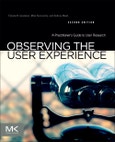Observing the User Experience: A Practitioner's Guide to User Research aims to bridge the gap between what digital companies think they know about their users and the actual user experience. Individuals engaged in digital product and service development often fail to conduct user research. The book presents concepts and techniques to provide an understanding of how people experience products and services. The techniques are drawn from the worlds of human-computer interaction, marketing, and social sciences.
The book is organized into three parts. Part I discusses the benefits of end-user research and the ways it fits into the development of useful, desirable, and successful products. Part II presents techniques for understanding people's needs, desires, and abilities. Part III explains the communication and application of research results. It suggests ways to sell companies and explains how user-centered design can make companies more efficient and profitable. This book is meant for people involved with their products' user experience, including program managers, designers, marketing managers, information architects, programmers, consultants, and investors.
Please Note: This is an On Demand product, delivery may take up to 11 working days after payment has been received.
Table of Contents
Part I: Why Research is Good and How It Fits Into Product Development1. Typhoon: A Fable
2. Do a Usability Test Now!
3. Balancing Needs Through Iterative Development
4. The User Experience
Part II: User Experience Research Techniques
5. The Research Plan
6. Universal tools: Recruiting and Interviewing
7. User Profiles
8. Contextual Inquiry, Task Analysis, Card Sorting
9. Focus Groups
10. Usability Tests
11. Surveys
12. Ongoing Relationship
13. Log Files and Customer Support
14. Competitive Research
15. Others' Hard Work: Published Information and Consultants
16. Emerging Techniques
Part III: Communicating Results
17. Reports and Presentations
18. Creating a User-Centered Corporate Culture
Appendices
A. The Budget Research Lab
B. Common Survey Questions
C. Observer Instructions








